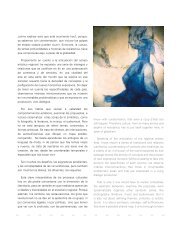yacían ensangrentados en las instalaciones carcelarias. Sesenta y ...
yacían ensangrentados en las instalaciones carcelarias. Sesenta y ...
yacían ensangrentados en las instalaciones carcelarias. Sesenta y ...
Create successful ePaper yourself
Turn your PDF publications into a flip-book with our unique Google optimized e-Paper software.
No debe resultarnos insólito <strong>en</strong>tonces que seamos reconocidos<br />
y cualificados a partir de relatos inscritos a la<br />
viol<strong>en</strong>cia -ya sea de orig<strong>en</strong> natural o humano- y que de<br />
alguna manera sirv<strong>en</strong> para que el mundo “civilizado” se<br />
explique a sí mismo -o no- por qué somos países “<strong>en</strong> vías<br />
de desarrollo”.<br />
Pero volvi<strong>en</strong>do el tiempo diez años atrás, podemos<br />
decir que <strong>en</strong>tonces nos proponíamos desde la Habana,<br />
con la colaboración de la desaparecida Galería Portales y<br />
la ayuda inestimable de artistas hondureños de difer<strong>en</strong>tes<br />
g<strong>en</strong>eraciones, realizar un recorrido por la plástica del<br />
país, que describieran los procesos histórico-artísticos<br />
acontecidos <strong>en</strong> los últimos cincu<strong>en</strong>ta años. Partíamos<br />
justam<strong>en</strong>te de la aus<strong>en</strong>cia del arte c<strong>en</strong>troamericano de<br />
la historiografía (tradicional) del arte de América Latina.<br />
No por ya dicho deja de ser relevante que la refer<strong>en</strong>cia<br />
a la producción artística del Istmo, ha sido utilizada por<br />
muchos investigadores ap<strong>en</strong>as como un dispositivo que<br />
permitió <strong>en</strong> su mom<strong>en</strong>to la “comparación” <strong>en</strong>tre zonas<br />
desiguales <strong>en</strong> su similitud; o bi<strong>en</strong> para complem<strong>en</strong>tar<br />
algún <strong>en</strong>unciado g<strong>en</strong>eral otro, sin que esto motivara un<br />
análisis más profundo <strong>en</strong> torno a los procesos culturales<br />
de la región.<br />
La exclusión de C<strong>en</strong>troamérica de este marco de<br />
reflexión obstaculizó por supuesto, no sólo cualquier<br />
int<strong>en</strong>to por llegar a ese territorio desde una perspectiva<br />
investigativa, sino que también reveló la inexist<strong>en</strong>cia de<br />
fu<strong>en</strong>tes que ord<strong>en</strong>aran consci<strong>en</strong>te y metodológicam<strong>en</strong>te,<br />
una historia de la plástica de la región. Y es que hablamos<br />
de un espacio inm<strong>en</strong>so <strong>en</strong> términos indagatorios,<br />
precisam<strong>en</strong>te por el vacío que ha experim<strong>en</strong>tado a nivel<br />
de estudios teóricos sobre su producción plástica.<br />
Lo cierto es que la car<strong>en</strong>cia de textos refer<strong>en</strong>tes al arte<br />
c<strong>en</strong>troamericano ha obligado a establecer sobre todo <strong>en</strong><br />
los últimos años, espacios que han servido para romper,<br />
<strong>en</strong> primer lugar, con evaluaciones que se han difundido<br />
de manera estandarizada d<strong>en</strong>tro de la Historia del Arte<br />
al uso, y <strong>en</strong> segundo lugar, con posturas que abusan de<br />
recognized and qualified from narratives subscribed to<br />
viol<strong>en</strong>ce –be it of natural or human origin—that somehow<br />
help the civilized world explain to itself (or not) why are<br />
we “developing countries.”<br />
But, going back t<strong>en</strong> years into the past, we can say<br />
our objective th<strong>en</strong>, back in Havana, with the collaboration<br />
of Galería Portales (now closed) and the invaluable help<br />
of Honduran artists of various g<strong>en</strong>erations, was to do a<br />
tour of the country’s visual arts, describing the historic<br />
and artistic processes of the <strong>las</strong>t fifty years. Our starting<br />
point was precisely the abs<strong>en</strong>ce of contemporary art<br />
in the (traditional) historiography of Latin American<br />
art. It has already be<strong>en</strong> said that refer<strong>en</strong>ces to the<br />
artistic production of the Isthmus has be<strong>en</strong> utilized by<br />
many scholars as a mere device used at some point<br />
to “compare” dissimilar areas, or to supplem<strong>en</strong>t some<br />
other formulation, not to spark a more profound analysis<br />
of the region’s cultural processes.<br />
The exclusion of C<strong>en</strong>tral American from these studies<br />
not only was an obstacle, not only for any attempt to<br />
reach this territory from an inquisitive perspective, but<br />
it also revealed the non-exist<strong>en</strong>ce of sources for an<br />
orderly, consci<strong>en</strong>tious and methodical history of the<br />
region’s visual arts. We are talking about a trem<strong>en</strong>dous<br />
undertaking in investigation, precisely because of the<br />
non-exist<strong>en</strong>ce of theoretical studies about the visual arts<br />
production in the area.<br />
The truth is that the lack of textual refer<strong>en</strong>ces to C<strong>en</strong>tral<br />
American art has forced to establish, especially in the <strong>las</strong>t<br />
few years, spaces that have served to break, in the first<br />
place, with judgm<strong>en</strong>ts that have become standard in art<br />
history ad usum, and, second, with postures that abuse<br />
simplistic and complac<strong>en</strong>t uses of localism wh<strong>en</strong> it is<br />
time to judge art produced in the Isthmus. The majority<br />
of C<strong>en</strong>tral American artists stayed somewhat removed<br />
from the avant-garde movem<strong>en</strong>ts that swept much of<br />
30 32 34 36 38 40 42 44 46 48 50 52 54 56



